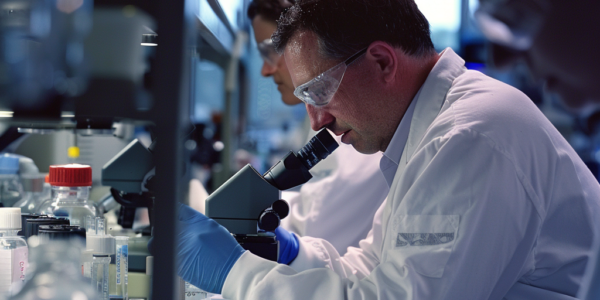Lyrid Meteor Shower Set to Light Up the Night Sky
The Lyrid meteor shower, one of the oldest known meteor showers, is set to light up the night sky starting next week. This annual event will begin on Monday and continue through April 29, with its peak expected in the late evening of April 21 through dawn on April 22. First recorded by the Chinese in 687 BC, the Lyrid meteor shower is a spectacle that can be observed by people across the world.
Researchers Connect Lab-Grown Brain Tissues to Mimic Human Brain Networks
Researchers have achieved a significant breakthrough in neuroscience by successfully connecting lab-grown brain tissues to mimic complex networks found in the human brain. This innovative method involves linking ‘neural organoids’ with axonal bundles, enabling the study of interregional brain connections and their role in human cognitive functions. The connected organoids exhibited more sophisticated activity patterns, demonstrating both the generation and synchronization of electrical activity akin to natural brain functions. This achievement not only enhances our understanding of brain network development and plasticity but also opens new avenues for researching neurological and psychiatric disorders, offering hope for more effective treatments.
New Strategy for Assessing Applicability of Chemical Reactions Developed by University of Münster Chemists
Chemists at the University of Münster have developed a computer-aided, bias-free method for selecting model substrates to evaluate new chemical reactions, aiming to improve the quality and information content of chemical reaction data and close knowledge gaps. The method is based on the complexity and structural properties of real pharmaceutical compounds, with the goal of lowering the barriers to the application of new reactions in both academic and industrial contexts. The work, published in the journal ACS Central Science, aims to initiate a ‘rethinking process’ in the evaluation of chemical reactions and represents an important step towards standardizing and objectifying the development and evaluation of chemical reactions.
Groundbreaking Discovery of Ancient Amino Acids in Dinosaur Eggshell Fossils Sparks New Excitement in Paleobiology
Groundbreaking study reveals ancient amino acids in titanosaur eggshell, sparking new potential for understanding ancient life. Dr. Kirsty Penkman expresses elation at the unexpected discovery, opening new avenues for scientific inquiry and offering valuable insights into the preservation of organic material.
Natural Protein Citrate Synthase Self-Assembles into Fractals, Study Shows
A recent study published in Nature has reported the emergence of a natural protein, citrate synthase from the cyanobacterium Synechococcus elongatus, which self-assembles into Sierpiński triangles. The research utilized cryo-electron microscopy to reveal how the fractal assembles from a hexameric building block and found that different stimuli can modulate the formation of fractal complexes. Despite the discovery, the study suggests that the fractal may not serve a physiological function in vivo, but the discovery of a natural protein self-assembling into fractals sheds light on the potential complexity and beauty of molecular-scale structures in nature.
Physicists Capture Direct Observational Evidence of Wigner Crystal, a Quantum Phase of Matter
Physicists have achieved a significant breakthrough in capturing direct observational evidence of a Wigner crystal, a peculiar form of matter proposed by theoretical physicist Eugene Wigner almost 90 years ago. This crystal, made up of free electrons forced together in a neat, crystalline lattice without atoms, has long been a subject of fascination and study. Al Yazdani, a physicist from Princeton University, expressed the significance of visualizing the Wigner crystal, stating that it not only confirms many of its properties but also enables new avenues of study that were previously inaccessible. The visualization of the Wigner crystal provides a unique opportunity to delve into the behavior of this quantum phase of matter, shedding light on its formation and properties. This breakthrough opens up new possibilities for further exploration and understanding of the fundamental nature of matter.
Breakthrough in RNA Medicine: Small-Molecule Inhibitors Developed Against RNA-Modifying Enzyme METTL16
Discover the groundbreaking research at the Chemical Genomics Center at the Max Planck Institute of Molecular Physiology in Dortmund, where scientists have developed the first small-molecule inhibitors against the RNA-modifying enzyme METTL16. This significant breakthrough paves the way for the development of therapeutic agents targeting RNA modifiers, bringing us closer to understanding the role of RNA in health and disease.
Debating the Possibility of Life in Venus’ Clouds
Could life exist within Venus’ voluminous clouds? New research suggests that it might be possible. Despite the harsh conditions on Venus’ surface, scientists are debating the possibility of life in the planet’s clouds. Recent research has raised questions about the potential for life in its atmosphere, with the detection of phosphine in Venus’ atmosphere sparking discussions about the presence of life. A new paper explores the possibility of microscopic life existing and reproducing in water droplets in Venus’ clouds, challenging our perceptions of where life could exist beyond Earth.
Archaeological Study Suggests Cultural Diversity Increases Biodiversity of Ecosystems
Recent archaeological study suggests that cultural diversity has a positive effect on the biodiversity of ecosystems. The research challenges the idea that humans lived harmoniously with nature as hunter-gatherers and emphasizes the complex relationship between human cultural diversity and ecosystem biodiversity.
The Role of Crustal Carbonate Build-Up in Earth’s Oxygenation
A recent study published in Nature Geoscience sheds light on the role of crustal carbonate build-up as a driver for Earth’s oxygenation, presenting a theoretical framework for the long-term global oxygen, phosphorus, and carbon cycles. The findings reveal that the accumulation of carbonates in the Earth’s crust has a significant impact on the planet’s oxygenation trajectory in both the atmosphere and oceans, providing valuable insights into the complex interplay between geological and biological processes that have shaped Earth’s atmosphere and oceans over billions of years.










